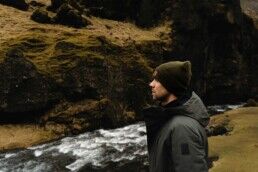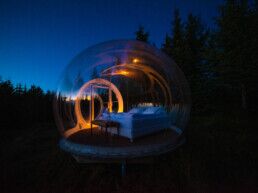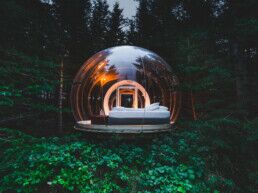- Home
- Travel Guide
- Exploring Kvernufoss: A Secret Slice of Paradise in Iceland’s Rugged Landscape

Exploring Kvernufoss: A Secret Slice of Paradise in Iceland's Rugged Landscape
If you’re more of a free-spirited traveler who likes the thrill of taking the road-less-traveled, then Kvernufoss waterfall is your place to be.
Kvernufoss is a humble falls located in South Iceland right next to the mighty and famous Skogafoss. Being next to this big and powerful waterfall, is one of the biggest reasons why it remains as a hidden gem. On top of that, not a lot of tours also include Kvernufoss in their itinerary, so you most probably need to take matters in your hands and visit it by yourself.
Although not as mighty as Skogafoss which has a 40 meter drop, Kvernufoss is still pretty tall with a 30 meter height. Moss-filled rock formation surrounds the falling water and looks like something you can only see in a fantasy movie.
Even better, there is a roomy cave behind the cascading water that lets you view the fall from the inside. Kvernufoss is one of the very few falls in Iceland that lets you do that and to think you get to enjoy the place all to yourself? It’s definitely a path worth taking.
Kvernufoss Waterfall: South Iceland's Best-Kept Secret
As mentioned, Kvernufoss waterfall is in South Iceland. Specifically, it’s close to the Skogar Cultural Heritage Museum and right next to the Skogafoss waterfall.
The water from the Kvernufoss comes from the river Kvernuhólsá or for short Kverna and later falls to the 30-meter cliff of the beautiful gorge Kvernugil. Do note that Kvernufoss is different from similarly named Kvernárfoss in the Kverná river which is located far in the Snaefellsnes Peninsula.
Not many tourists pay Kvernufoss a visit as they flock to the more famous Skogafoss, and even though it’s now more featured in many blog posts or articles online, tourists just tend to not have the time to visit. It’s also easy to miss if you’re not aware it even exists since the beautiful gorge around hides it very well.
This is great news if you’re looking for a stop that’s not too crowded and want a stunning destination that you can enjoy in peace.
Kvernufoss is undoubtedly beautiful; the moss-filled volcanic rock cliffs surrounding the fall provide a good contrast to the clear water and some of the brownish exposed parts of the cliff. If you think the view from the front is good enough, you will not believe how it looks from the back.
Kvernufoss is among the very few falls in Iceland that allow you to cross a path behind the waterfall. This is why it’s also regarded as Seljalandsfoss’s little sister, another fall that lets you walk behind its water.
Seljalandsfoss is larger and more popular, but it looks the same as Kvernufoss since both are surrounded by mossy cliffs and volcanic rock formations.
The walkway leading to a roomy cave behind the fall can be found on the side, and crossing it will cause you to be wet. It’s important to wear a raincoat or a waterproof jacket. The path is also slippery, so watch your step and wear shoes with a good grip.
Surprisingly, the cave behind the waterfall is pretty roomy, and after you cross the path, it’s all just cozy and dry. Seeing the bright green view from the cascading water while you hear its rhythmic sound is a taste of calm that’s very well worth the short trip.
To exit the cave, you will take the same trail you entered.
How to Reach Kvernufoss
Kvernufoss is 156 km away from Reykjavik and from Vik it’s 34 km away. You can reach it either through car, public transportation or as part of a tour.
If you’re driving here with a rented car, take the Ring Road number 1 from Reykjavik and the trip should take about 2 hours. It’s really nice to look at the changing view throughout your ride from the lively capital to more remote and lush rural landscape. If you’re coming from Vik the drive is shortened to 30 minutes.
There is no designated parking for the fall alone so the nearest spot you can park on is at the Skogar Cultural Heritage Museum. The trail directly starts from the parking lot. You need to pay a 500 ISK or $3.5 parking fee at the museum which you can pay using the Parka app.
If you’re taking public transportation, you can catch a bus from Reykjavík to Skóga that will take you to Skógar Campsite near the main road and close to Skógafoss waterfall. You will then walk 1.8 km, which should take 20 minutes depending on your pace before reaching the trailhead of Kvernufoss.
You can also try to find tours that offer a visit to the falls. Since it is growing in popularity, tours are starting to include it in their itinerary in combination to more famous nearby attractions.
Hike to Kvernufoss
The hike from the trailhead to Kvernufoss should take you 15-20 minutes. So back and forth, the hike should take about 1 hour. But ofcourse this could still span longer, depending on how fast you walk or how many stops you take.
The trail is graveled and almost completely flat so it should be easy to walk through, but as you slowly reach the waterfall, you will have to cross a short but steep hill towards the canyon. This is where you will first catch a glimpse of the hidden fall.
Since a part of the starting point of the trail is sitting on private property, you will also need to cross a stile at the beginning of your hike. Just look for the small ladder made of metal and walk through it to cross over the boundary. It’s not hard to do, but it does feel a little awkward going up and down the ladder.
Sadly, this is a challenge for people with mobility issues, and there is no other path to take. So it’s probably a better idea to just head on to the more accessible Skogafoss.
After getting through the boundary, you just have to follow the mostly level trail getting to the River Kverna. Then climb shortly up a hill to finally reach the beautiful Kvernufoss.
Photography at Kvernufoss
Because it’s less traveled and fewer people know about it, Kvernufoss is the perfect destination to take some awesome cinematic shots. Without the huge crowd, you can take your time taking long shots and capturing the falls’s intricate details without worrying about photobombers suddenly showing up.
In fact, photographers have realized just how good of a location Kvernufoss is that many prenups as well as wedding photos have been taken around the fall. But it’s not just in the fall too, the trail is also good as a beautiful backdrop.
What professional photographers like so much about this place is the many options of views and angles to choose from. You take photos from the path, the fall, behind the fall and against the green-colored rocks. To capture the entirety of the landscape, opt for a wider shot, but if you want something to look more intimate, take some close ups.
Taking photos from the back of the fall is very scenic and a silhouette shot is a must. You do have to bring a wide lens to perfectly capture the whole mouth of the cave. Long shots come out great since the details are more vivid. If you’re lucky, a rainbow might even show up as this is a misty side of the fall.
Before heading here, make sure to bring a waterproof sleeve for your camera.
If you’re not a professional photographer, you will still have fun taking pictures. The fall is pretty enough to look great even on your iPhone’s camera and it’s a really fun activity to make use of your phone’s wide lens feature.
Is Kvernufoss Worth the Visit?
Absolutely, especially if you’re already on a stop to the Skogafoss. Taking the short trip from Skogafoss to Kvernufoss is not that hard but the reward is totally worth it.
The waterfall is humble compared to Skogafoss, but with less people, it just feels more serene and calming. You will not have to feel pressured with time or overwhelmed with the crowd.
Crossing the fall is also a nice touch as it makes the visit more of a full-body experience.
Numerous travelers both local and foreign choose Kvernufoss as their favorite waterfall in the South Coast, and considering the level of competition, that’s a pretty big title to claim.
What You Should Know Before Visiting Kvernufoss
It’s better to visit Kvernufoss in the summer when the ground is dry and the days are longer. It is also the only time when you are allowed to go behind the fall. Although it is the peak season of tourism in Iceland, the place will still be less crowded since people are busy going up the nearby Skogafoss.
You should bring a raincoat or a waterproof jacket during summer or any other time you visit Iceland. This is because most tours include a waterfall or a wet destination of some sort.
During winter, Kvernufoss turns from a lush green field to a snowy one. It’s totally different and has a cooler appeal. But if you decide to visit around this time, wear thick and warm hiking gear complete with crampons.
It’s not worth the risk to cross the trail behind the water in winter. The trail is covered in ice and very slippery even if you are wearing crampons, plus, there is also a possibility of icicles falling from the cliff above.
Trash bins and comfort rooms can be located in the museum’s parking lot. The comfort room can only be used if you’re visiting the museum, buying from the cafe inside or have already paid the parking fee.
Before heading off to the trail, make sure you’re completely comforted and only throw whatever trash you have in the cans here.
Attractions To Visit Near Kvernufoss and Around the South Coast of Iceland
The South Coast is one of the best parts of Iceland. There are many incredible destinations to hit and hidden treasures like Kvernufoss to discover.
Iceland’s South Coast is particularly surrounded by a lot of waterfalls. The nearest being Skógafoss which is just next to Kvernufoss. Skógafoss is known as Iceland’s most powerful waterfall, and it is the second most powerful waterfall in all of Europe. It is very popular and included in most tours so reaching it will not be a problem.
Obviously, since you’re already parking there, you might as well enter the Skogar Cultural Heritage Museum. It’s a combination of technical, folk and open-air museum. The folk one has over 15,000 artifacts, while the open-air museum jfeatures traditional turf-roof houses.
The museum’s cafe is also good for a quick lunch or coffee time before starting your hike or after you visit Kvernufoss.
Other nearby waterfalls worth checking out include Seljalandsfoss, (Kvernufoss’s big sister) which you can also walk behind, and Gljúfrabúi, a unique waterfall inside a cave that gives you a wet experience.
Down the road, you can also visit another hidden fall called Gluggafoss. It’s more cozy and tiny, but you can also walk behind the low flowing water and enjoy some peaceful time by yourself.
In the nearby town of Vík, you can find the famous black beach, Reynisfjara. It is another tourist destination known for its black volcanic sand and crooked sea stacks. In Vik also lies the Dyrhólaey viewpoint and Katla Ice Cave.
But just the town of Vik alone is already charming. It has a very homey vibe to it and looks straight out of a postcard so tourists naturally enjoy lounging here.
The Jokulsarlon glacier lagoon is also located within the South Coast. It is regarded as the “Crown Jewel of Iceland,” and once you get there and see it for yourself, it’s not hard to understand why. The lake is glistening with big and old icebergs flowing on top of it and reflecting light. Even more, Jokulsarlon glacier lagoon is rich in wildlife so you can enjoy watching seals and arctic terns that often hang around.
Last but not the least, Vatnajokull glacier is another popular destination and claims the title of the biggest glacier in Europe.

Robert Robertsson
Hey, I'm the founder of Airmango. My love affair with travel and entrepreneurship kicked off in 1994 in Iceland. Fast forward through two decades, and I've been lucky enough to weave my career through five different countries. Each place has left its mark on me, not just in my personal life, but in how I approach business too. With Airmango, I'm bringing all those global insights and experiences to the table – it's like seeing the world through a business lens.

